Early breakfast, and the day begins with a dinghy ride through Black Turtle Cove, where you can find 4 species of mangrove, and where you will spot turtles, herons, sharks and rays. After this activity you will be transferred to Baltra´s airport, to take your flight back to the continent.
Departure from Quito or Guayaquil to San Cristobal (2 1/2 hours flight). Arriving in Galapagos,
passengers are picked up at the airport by our naturalist guides and taken to the pier to
board the M/Y Coral I or M/Y Coral II.
Interpretation Center & Frigatebird Hill (San Cristobal Island) : The interpretation center is full of interesting information and offers the perfect overview to the formation of Galapagos, its significance in the world, threats and conservation efforts. Followed by a hike to Frigatebird Hill (Cerro Tijeretas) we will have great looks at both species of frigatebird, with the bonus of a beautiful view of the bay below.

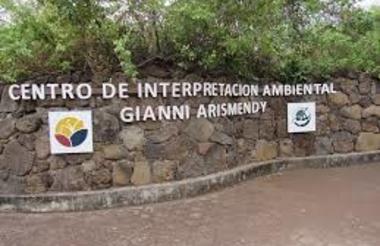

Kicker Rock & Cerro Brujo (San Cristobal Island): Kicker Rock Circumnavigation (San Cristobal Island) This ancient and eroded volcanic Activity : Circumnavigation tuff lava named Leon Dormido or Kicker Rock it is formed by two rocks approximately 148 m, named for its resemblance of a sleeping lion.
Punta Pitt &Pitt Islet (San Cristobal Island): Sea lions will greet us as we land on the beach and prepare for our climb to a high point on the steep eroded tuff cone. This is the only place in the islands where we will enjoy the chance to see all three of the booby species in the same place. The red-foots will be perched on the Cordia lutea and small trees, the Nazcaís on the ground near the cliff edge while the blue-foots will be a little further inland. Frigatebirds will be all around and the views are breathtaking.

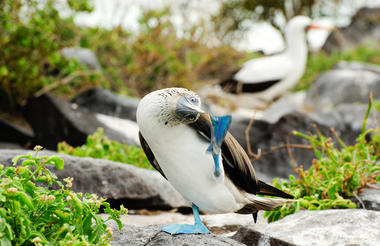

Punta Suarez (Espanola Island): One of the highlight visits of the trip. Punta Suarez seems to have everything - a naturalistís paradise. A slew of marine iguanas and sea lions greet us at the landing site from where our walk continues with close encounters of boobies, endemic lizards, gulls and even a dramatic blow hole. The oldest extant island in the archipelago it is our only opportunity to commune with the endemic waved albatross during their breeding season between April and December. With luck, we can watch their complex courtship display.
Gardner Bay, (Espanola Island): One of the most stunning beaches in all of Galapagos. The long, white, sandy beach, lapped by turquoise waters is home to a colony of Galapagos sea lions, indifferent to the humans that walk amongst them. The Hood mockingbirds, endemic to this particular island, will be eager to inspect the visitors and satisfy their innate curiosity. Darwinís finches may also join the throng including the reclusive warbler finch. We can also snorkel here from the beach, in the shallows of the bay
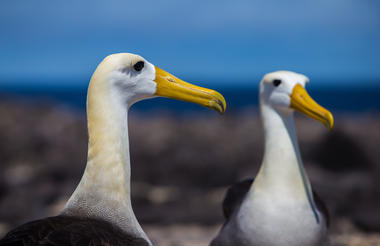
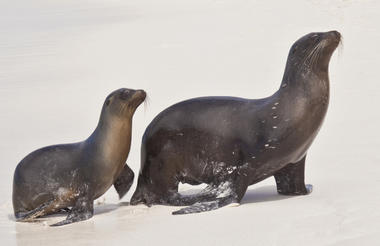

Punta Cormorant or Champion Islet (Floreana Island): Wet landing, on an olivine green, sanded beach. We hike from the black mangrove beds to a brackish lagoon, which usually holds one of the largest flamingo populations in the Galapagos. This island features some endemic plants such as Scalesia villosa, white and black mangrove, and holy stick. The trail continues to a beautiful white sandy beach, one of the most important nesting sites of Green Pacific Sea Turtles. It is important to avoid walking in the water due to the Sting Rays that may be hiding in the sand, which can be dangerous if accidentally stepped on. From the beach, one can spot sea turtles, blue-footed boobies plunging into the water, and small reef sharks floating along the shoreline in the search for food. This coral-sand beach marks the end of our trail, and we head back to the olivine beach we landed on, to swim or snorkel amongst sea turtles, reef fish, sea lions and, on a good day, white-tipped reef sharks. A small colony of penguins resides on Floreana and can sometimes be observed as well.
Post Office Bay: Wet landing. Located on the north side of Floreana, the bay was named because in 1793 Captain James Colnett installed a wooden barrel which served as an informal post office for sailors passing through, who would take letters with them back to their destinations. Today, visitors continue the tradition by placing unstamped postcards inside the barrel, hoping that some other traveler, going to the letter destination, will take it back for free. The chances are that the letter posted can take a long time to arrive at its destination. However, there have been cases where it has arrived before the sender. We may also encounter Darwin’s finches, Yellow Warbler and Lava Lizards. Great snorkeling opportunities with Green Pacific Sea Turtles. As well, the island is best known for its endemic vegetation: Scalesia villosa, Lecocarpus Pinnatifidus, and the Galapagos Milkwort. Snorkelers can practice on the main beach among playful sea lions.



Highlands Tortoise Reserve : In the mountains of Galapagos is possible to admire different kind of birds, such as: tree and ground finches, vermillion flycatchers, paint-billed crakes, yellow warblers, and cattle egrets (usually standing on the tortoises’ shell). The journey to the reserve offers great opportunities to see the contrasts that the island offers in reference to the variety of ecosystems. The road goes from the coast through the agricultural zone and straight up to the dense humid forests. Often, Galapagos Giant Tortoises are also seen on the way, wandering through pastures in the paddocks. This spot is a birdwatchers’ haven, since almost every land bird present on the island lives or migrates here.
Charles Darwin Research Station: Once home to the famous Lonesome George, the last tortoise of the Pinta race, the breeding and relocation center is named in honour of his long-time guardian. The center is set in the Galapagos National Park Service where various interpretative buildings are available to visit. The grounds, with large stands of native vegetation are one of the better places to spot some of the seldom seen Darwinís finches such as the woodpecker, cactus and vegetarian finches.
Carrion Point: Dinghy ride at the entry of the Itabaca Channel in a lagoon with turquoise water, where we can observe sharks, blue-footed boobies, and different kinds of fish.
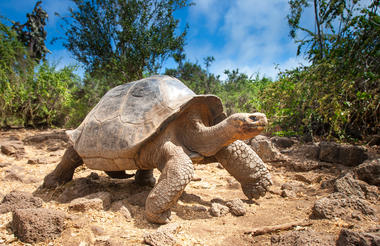
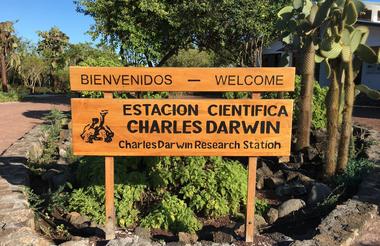

Breakfast
Lunch
Dinner
El Barranco, Prince Philip´s Steps (Genovesa Island): Be marvelled at the variety of sea life that uses the crevices of the lava cliffs for shelter. Red-billed Tropicbirds fly overhead, switching between their nests and the bay, and a small colony of fur seals may be found near the landing site. You will be dropped off at a steep stairway that begins on rocks at the foot of a path that leads through a seabird colony full of Nazca and Red-footed Boobies. At the plateau, the trail continues inland allowing you to see more nesting booby colonies in the thin Palo Santo forest. Near the end of the trail, over a rocky lava plain, Wedge-rumped Storm-Petrels can be observed flying in all directions. If you are lucky, you may catch a glimpse of a Short-eared Owl.
Darwin Bay: Disembark onto a small sand and coral beach. A short trail heads west along a tidal lagoon and then up a rocky hill that leads to a point overlooking the cliffs and Darwin Bay. Along the trail near the tidal lagoon, visitors will see pairs of Swallow-tailed Gulls, Lava Gulls, Yellow-crowned and Lava Herons. The trail continues through Palo Santo trees, Opuntia cacti, and Saltbushes inhabited by Great Frigate birds and Red-footed Boobies. This is one of the few places in the islands where visitors are guaranteed to see Red-footed Boobies. It is estimated that more than 200,000 Red-footed Boobies live in the trees and bushes of Genovesa.



Rabida Island: Wet landing. Dark-red sand covers the unique beaches of this island, home of sea lions
colonies; Rabida is considered the epicenter of the Galapagos Islands due to the diversity of its volcanic geology. Nesting brown pelicans are found from July through September plus nine species of the famous Darwin’s finches. Here a dinghy ride along marine cliffs is done, to observe nesting seabirds. Snorkel off the coast, where marine life is particularly active.
Bartolome Island: Dry or wet landing. We discover a fascinating landscape formed by different volcanic parasitic cones —lava bombs, spatter, cinder cones — that resembles the moon. Going up to the summit there will be an impressive views of the surrounding islands, including the eroded tuff cone Pinnacle Rock. We also encounter marine iguanas, lava lizards, and blue-footed boobies. Beach time is a great opportunity to do snorkeling and see the famous Galapagos Penguins, sea turtles and White-tipped Reef Sharks among a great variety of colorful fish. For many visitors, this may turn out to be the best snorkeling experience. Crystal clear water is the perfect spot to appreciate the incredible marine life it has to offer. Due to its geographical location, the lack of vegetation is immediately noticeable however, there are pioneer plants including the endemic Tiquilia nesiotica and Chamaesyce (known as sand mat or spurge in English), lava cactus, and Scalesia bushes.

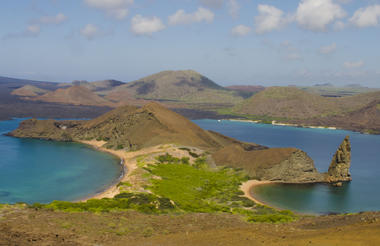

Breakfast
Lunch
Dinner
Pitt Craters: The Pit Craters, geologically speaking, were not directly formed by volcanic action. They
were created as a result of the collapse or sinking of surface materials into cracks or
manholes. It’s a great place to spot vermilion fly catchers as we walk inside an endemic
Scalesia forest. Great opportunity to observe giant tortoises.
After the visit, passengers will be transferred to the airport for their return flight to Guayaquil or Quito.
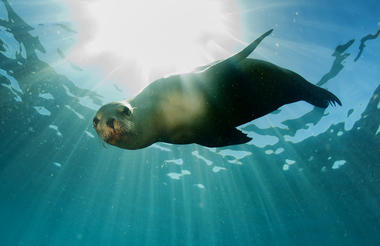

Breakfast








